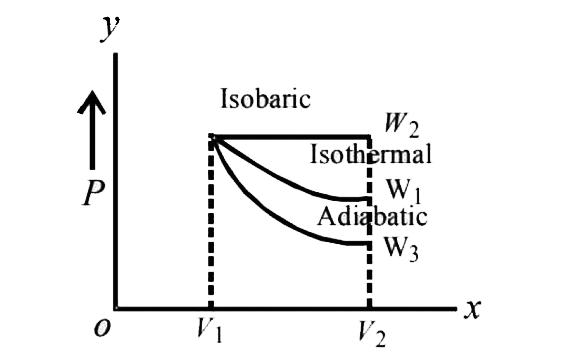A sample of gas expands from volume V1 to V2. The amount of work done by the gas is greatest when the expansion is
Isothermal
Isobaric
Adiabatic
Equal in all cases
The correct Answer is:B
As P constant. Work done (W) = P(V2−V1).
Topper's Solved these Questions
- BOOK - ERRORLESSCHAPTER - THERMODYNAMICSEXERCISE - ASSERTION AND REASON20videos
THERMODYNAMICS
- BOOK - ERRORLESSCHAPTER - THERMODYNAMICSEXERCISE - NCERT BASED QUESTIONS (HEAT ENGINE, REFRIGERATOR AND SECOND LAW OF THERMODYNAMICS)35videos
THERMODYNAMICS
- BOOK - ERRORLESSCHAPTER - SURFACE TENSIONEXERCISE - ASSERTION & REASON11videos
SURFACE TENSION
- BOOK - ERRORLESSCHAPTER - THERMOMETRY, THERMAL EXPANSION AND CALORIMETRYEXERCISE - ASSERTION & REASON10videos
THERMOMETRY, THERMAL EXPANSION AND CALORIMETRY
Similar Questions
A gas expands under constant pressure P from volume V1 toV2The work done by the gas is
View SolutionStarting with the same initial conditions, an ideal gas expands from volume V1 to V2 in three different ways, the work done by the gas is W1 if the process is purely isothermal, W2 if purely isobaric and W3 if purely adiabatic, then
View Solution
Knowledge Check
- Question 1 - Select One
Starting with the same initial conditions, an ideal gas expands from volume V1 to V2. The amount of work done by the gas is greatest when the expansion is
AisothermalBisobaricCadiabaticDequal in all cases - Question 2 - Select One
The work done by a gas is maximum when it expands
AisothermallyBadiabaticallyCisochoricallyDisobarically - Question 3 - Select One
The amount of work done by the gas during expansion is greatest by
AIsobaric processBIsothermal processCAdiabatic processDSame in each process
Starting with the same initial conditions, an ideal gas expands from volume V1 to V2 in three different ways. The work done by the gas is W1 if the process is purely isothermal, W2 if purely isobaric and W3 is purely adiabatic. Then
View SolutionWith same initial conditions , an ideal gas expands from volume V1 to V2 in three different ways . The work done by the gas is W1 if the process is isothermal , W2 if isobaric and W3 if adiabatic , then
View SolutionStarting with the same initial conditions, an ideal gas expands from volume V1→V2 in three different ways. The work done by the gas is W_1 if the process is purely isothermal, W2if purely isobaric and W3 if purely adiabatic. Then
 View Solution
View SolutionStarting with the same initial conditions, an ideal gas expands from volume V1 to V2 in three different ways, the work done by the gas is W1 if the process is purely isothermal, W2 if purely isobaric and W3 if purely adiabatic, then
View SolutionIf same amounts of each of the four gases were taken, on expanding from a volume V1 to V2, the maximum work will be done in the case of
View Solution

